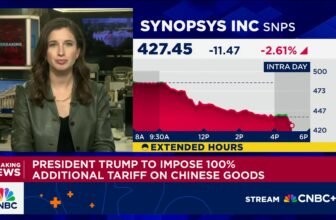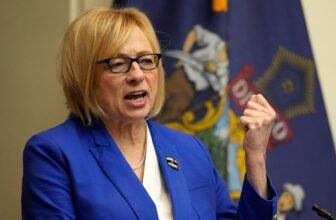Latest Election Predictions: How Kamala Harris Could Still Lose to Donald Trump

Introduction
The political landscape leading up to the forthcoming U.S. presidential election is marked by intense scrutiny and anticipation. At the forefront of this electoral battle are two prominent figures: Kamala Harris, the current Vice President, and Donald Trump, the former President, who is seeking to regain his seat in the Oval Office. As the election season unfolds, analysts and pundits are closely examining the dynamics that could influence the race’s outcome. Despite her position as the incumbent Vice President, Kamala Harris faces a formidable challenge from Donald Trump, whose robust base of supporters and resilient campaign strategies cannot be underestimated.
The upcoming election presents a myriad of factors that could sway voter sentiment and, ultimately, the results. These include the candidates’ policy positions, public perceptions, and the broader socio-economic environment. As we delve into the complexities of election predictions, it becomes evident that the race is far from a foregone conclusion. Kamala Harris, while holding the advantage of incumbency, must navigate a landscape fraught with political volatility and voter unpredictability.
Donald Trump, on the other hand, continues to galvanize his supporters with a message that resonates strongly within his base. His previous tenure and ongoing influence in the Republican Party add layers of complexity to the election narrative. As we explore the potential scenarios, it is crucial to understand the multifaceted nature of electoral politics and the various elements at play.
This blog post will delve into the key factors that could determine the election outcome, examining the strengths and vulnerabilities of both candidates. Through a detailed analysis, we aim to provide a comprehensive understanding of why Kamala Harris could still lose to Donald Trump, despite her current position in the administration. The stakes are high, and the road to the presidency is paved with uncertainties, making this election one of the most closely watched in recent history.
Current Polls and Predictions
The latest polling data and election predictions reveal a competitive race between Kamala Harris and Donald Trump. As of recent surveys, Harris holds a marginal lead in nationwide polls, but the gap narrows significantly in key battleground states. This trend underscores the unpredictable nature of the electoral landscape, where both candidates are vying for crucial swing state votes that could ultimately decide the outcome of the election.
Various methodologies are employed in these polls, ranging from telephone interviews to online surveys, each with its own strengths and limitations. Traditional telephone polls, often considered more reliable, typically feature a higher response rate from older demographics. Conversely, online polls tend to capture a more diverse cross-section of the population, including younger voters who are increasingly influential. The combination of these methodologies provides a comprehensive overview of voter sentiment but also highlights potential biases inherent in any single approach.
One notable change in voter sentiment is the apparent shift among independent voters. Initially leaning towards Harris, recent data suggest a segment of this demographic is reconsidering their stance, possibly swayed by economic concerns or foreign policy issues. This shift underscores the volatility and fluidity of voter preferences in the current political climate.
Additionally, the reliability of these polls hinges on several factors, including sample size, question framing, and the timing of the survey. Larger sample sizes generally yield more accurate results, while the wording of questions can significantly influence responses. Timing is also crucial; polls conducted closer to significant events, such as debates or policy announcements, might reflect temporary fluctuations rather than stable trends.
Although Kamala Harris maintains a slight advantage in the latest predictions, the race remains too close to call definitively. The emerging trends and shifting voter dynamics suggest that both campaigns must continue to adapt and engage with the electorate to secure a decisive victory.
Kamala Harris’s Key Policies
Kamala Harris has taken definitive stances on several critical issues, particularly in the realm of transgender care and surgery options. Harris has consistently advocated for the rights of transgender individuals, emphasizing the importance of providing comprehensive care, including puberty blockers and hormone therapies for children. Her position underscores a commitment to ensuring that transgender youth have access to necessary medical treatments to support their gender identity, aligning closely with the broader Democratic platform.
Harris’s views on transgender care are largely in harmony with those of President Joe Biden. Both leaders advocate for inclusive healthcare policies that support the needs of transgender individuals, showcasing a unified front on this issue. However, Harris has been particularly vocal about the need for federal protections that prevent discrimination against transgender individuals in healthcare settings, which highlights her proactive approach to this matter.
Beyond transgender care, Harris also holds significant views on parental care and children’s welfare. She supports increased funding for childcare and early childhood education, recognizing the critical role these services play in the development and well-being of children. Harris advocates for policies that ensure all families have access to affordable, high-quality childcare, which she believes is essential for the economic and social stability of communities.
Additionally, Harris has expressed a strong commitment to addressing systemic inequalities that impact children and families. She has called for expanded healthcare access, improved educational opportunities, and robust social safety nets to support vulnerable populations. These policies reflect her broader vision of creating a more equitable society where every child can thrive.
In summary, Kamala Harris’s key policies demonstrate a comprehensive approach to children’s welfare and transgender care. Her alignment with Joe Biden on these issues, coupled with her proactive stance on federal protections and parental support, underscores her dedication to fostering inclusive and supportive environments for all individuals.
Public Reaction to Harris’s Policies
Public reaction to Kamala Harris’s policies has been a mixed bag, with certain initiatives garnering significant support while others have faced considerable controversy. One of the most contentious areas has been her stance on transgender care for children. Advocates argue that her policies promote inclusivity and necessary medical support, but critics claim they are too extreme and potentially harmful.
For instance, Harris’s advocacy for easier access to gender-affirming treatments for minors has ignited a firestorm of debate. Proponents, including various LGBTQ+ organizations, argue that these policies are crucial for the mental health and well-being of transgender youth. They highlight the importance of providing supportive environments and necessary medical care to help these children thrive. Influential figures, such as several leaders from prominent LGBTQ+ advocacy groups, have publicly endorsed Harris’s stance, emphasizing that it aligns with broader efforts for equality and human rights.
However, this position has also attracted significant criticism. Opponents argue that such policies could lead to irreversible decisions being made at a young age. They call for more stringent guidelines and caution against what they see as premature medical intervention. Notable figures in the medical and psychological communities have voiced their reservations, suggesting that a more conservative approach might be warranted until more comprehensive research is available. These critics argue that the potential risks and long-term implications of these treatments are not yet fully understood.
Public opinion polls reflect this divide. Surveys indicate that while a segment of the population supports Harris’s progressive approach, there is a substantial portion that remains skeptical or outright opposed. This polarization is evident in the discourse surrounding her policies, with passionate arguments on both sides. The controversy over transgender care for children exemplifies the broader challenge Harris faces in balancing progressive initiatives with public acceptance and understanding.
Donald Trump’s Less Extreme Views
In the current political landscape, Donald Trump’s policy positions are often perceived as less extreme compared to Kamala Harris’s. One of the areas where this distinction is evident is in his stance on transgender care. Unlike Harris, who advocates for comprehensive healthcare rights for transgender individuals, Trump has taken a more conservative approach. He has expressed concerns about the implications of transgender care on various societal institutions, including the military and educational systems. This position resonates with a segment of the electorate that is apprehensive about rapid social changes.
Trump’s views extend beyond transgender care to other significant issues. For instance, his economic policies prioritize deregulation and tax cuts, which he argues will stimulate economic growth and job creation. This contrasts with Harris’s proposals for higher taxes on the wealthy and increased government spending on social programs. Voters who are wary of extensive government intervention in the economy may find Trump’s economic plans more appealing.
On immigration, Trump continues to advocate for stricter border controls and enforcement of existing laws. He emphasizes the need for a secure border and has proposed measures to curb illegal immigration. In contrast, Harris supports more lenient immigration policies, including pathways to citizenship for undocumented immigrants. Trump’s stance on immigration appeals to voters who are concerned about national security and the economic impact of illegal immigration.
Moreover, Trump’s foreign policy positions often emphasize a “America First” approach. He has focused on renegotiating trade deals and reducing U.S. involvement in international conflicts. This pragmatic stance is in stark contrast to Harris’s more globalist perspective, which includes a commitment to international alliances and multilateral agreements. Voters inclined towards nationalistic policies may find Trump’s foreign policy perspective more compelling.
Overall, Donald Trump’s less extreme views on transgender care, economic policy, immigration, and foreign policy provide a clear contrast to Kamala Harris’s more progressive positions. This differentiation may attract voters who are seeking a more conservative and traditional approach to governance.
Shifts in Voter Sentiment
In recent months, significant shifts in voter sentiment have become apparent, and these changes could play a crucial role in the upcoming election. Various polls and studies indicate that voter behavior is increasingly influenced by the stances and actions of Kamala Harris. Her policy proposals and public statements have sparked varied reactions among different voter demographics, contributing to a notable gravitation towards Donald Trump.
For instance, Harris’s firm stance on certain progressive issues has resonated well with younger, more liberal voters. However, it has also alienated some centrist and conservative-leaning individuals who feel that her policies are too radical. This division is evident in recent polling data. According to a survey by Pew Research, while Harris enjoys a 70% approval rating among Democrats, her approval drops to 30% among independents and a mere 10% among Republicans.
One of the most notable examples of this shift can be seen in her approach to healthcare reform. Harris’s endorsement of a single-payer healthcare system has been a double-edged sword. While it has solidified her support base among left-leaning voters, it has simultaneously driven moderate and conservative voters towards Trump’s promises of preserving private healthcare options. This polarization is further illustrated by a Gallup poll, which shows that 45% of undecided voters now lean towards Trump, up from 35% earlier this year, attributing their shift to concerns over Harris’s healthcare agenda.
Economic issues also play a pivotal role in shaping voter sentiment. Harris’s proposals for higher taxes on the wealthy and increased government spending have sparked fears of economic instability among some voters. In contrast, Trump’s narrative of economic recovery and job creation has gained traction, especially in rural and industrial regions. Data from a recent Quinnipiac poll reinforces this trend, showing a 10% increase in Trump’s favorability among voters in key swing states, largely driven by economic concerns.
These shifts in voter sentiment underscore the complexity of the current political landscape. Harris’s policy positions and public image will continue to influence voter behavior, potentially impacting the election outcome in ways that are still unfolding. Understanding these dynamics is crucial for predicting how the electorate may respond as the election approaches.
Key Battleground States
The outcome of the upcoming election largely hinges on key battleground states, which serve as the primary arenas of contest between Kamala Harris and Donald Trump. These states, often characterized by their fluctuating political leanings, hold the potential to sway the final result. Key battleground states such as Pennsylvania, Michigan, Wisconsin, Arizona, and Georgia are currently in the spotlight due to their significant electoral votes and historical unpredictability.
In Pennsylvania, voter sentiments are deeply divided. The state has a mix of urban areas leaning towards Harris and rural regions showing strong support for Trump. Economic policies and healthcare are critical issues here, with Trump advocating for deregulation and tax cuts, while Harris focuses on expanding healthcare access and social services. Polls indicate a tight race, with neither candidate establishing a clear lead.
Michigan, another pivotal state, is witnessing a robust contest. The manufacturing sector’s health and job creation are paramount to voters. Trump’s promises to revive American manufacturing resonate with some demographics, whereas Harris’s environmental policies and emphasis on green jobs appeal to younger voters and environmental advocates. Current standings show a slight edge for Harris, but the margin is narrow.
Wisconsin’s political landscape is similarly contested, with urban centers leaning Democratic and rural areas favoring Trump. Voter sentiments are influenced by issues such as trade policies and agricultural subsidies. Harris’s stance on supporting small farmers and sustainable agriculture contrasts with Trump’s focus on traditional farming methods and trade deals. The race remains highly competitive, with both candidates vigorously campaigning to sway undecided voters.
Arizona, traditionally a Republican stronghold, has emerged as a battleground due to shifting demographics and growing urbanization. Trump’s hardline immigration policies are a significant factor here, while Harris’s more inclusive approach appeals to the state’s increasing Latino population. Polls show a neck-and-neck race, reflecting the state’s evolving political dynamics.
Lastly, Georgia has become a focal point due to its rapidly changing electorate. Suburban areas, once reliably Republican, are now more competitive. Harris’s focus on criminal justice reform and voting rights resonates with minority communities, while Trump’s law-and-order message aims to secure his base. The state’s current standings indicate a highly competitive race, with efforts from both campaigns intensifying as election day approaches.
Conclusion and Final Thoughts
As we reflect on the latest election predictions, it is clear that Kamala Harris faces a significant challenge in her bid against Donald Trump. Despite various factors that could potentially swing voter sentiment, current public opinion suggests a competitive race. The analysis of polling data, campaign strategies, and key battleground states underscores the complexity of predicting the final outcome. While Harris holds certain advantages, such as a well-regarded political track record and substantial support within her party, Trump’s enduring influence and ability to mobilize his base cannot be underestimated.
Several critical elements remain in play as the election date approaches. Voter turnout, particularly among swing demographics, will be pivotal. Economic conditions, national security concerns, and ongoing societal issues could also sway undecided voters. Additionally, the performance of both candidates in debates and their ability to effectively communicate their platforms will be crucial. The potential impact of third-party candidates and any unforeseen developments, such as major political or social events, could further shift the electoral landscape.
Ultimately, the dynamic nature of electoral politics means that nothing is set in stone. Both Kamala Harris and Donald Trump must navigate an ever-evolving political environment, making real-time adjustments to their strategies. As the campaign progresses, staying informed about the latest developments and understanding the multifaceted factors at play will be essential for voters and analysts alike. The forthcoming election promises to be one of the most closely watched and hotly contested in recent history, with the potential for unexpected turns until the final votes are counted.
Tags: transgender care







